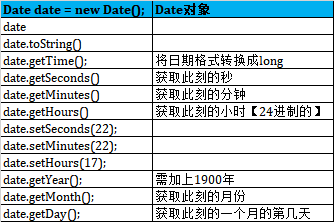1)根据当前时间,获取具体的时刻的时间
N天前
M小时之前
可用
new Date().getTime() - 24 60 60 1000N【N天之前】
的方法来获取处理时间之后的具体的值,
最终转化为想要的时间格式
import java.text.SimpleDateFormat;
import java.util.Date;
public class getTime {
public static void main(String[] args) {
SimpleDateFormat sd = new SimpleDateFormat("yyyy-MM-dd HH:mm:ss");
Date time = new Date(new Date().getTime() - 24 * 60 * 60 * 1000);
System.out.println(sd.format(time));
System.out.println(sd.format(new Date()));
//想获得N天之前或M天之后的时间
int NDay = 5;
int MDay = -10; //之后就传负数
Date timeN = new Date(new Date().getTime() - 24 * 60 * 60 * 1000 * NDay);
Date timeM = new Date(new Date().getTime() - 24 * 60 * 60 * 1000 * MDay);
System.out.println(sd.format(timeN));
System.out.println(sd.format(timeM));
//想获得N小时之前或M小时之后的时间
int NHour = 5;
int MHour = -10; //之后就传负数
Date timeNHour = new Date(new Date().getTime() - 60 * 60 * 1000 * NHour);
Date timeMHour = new Date(new Date().getTime() - 60 * 60 * 1000 * MHour);
System.out.println(sd.format(timeNHour));
System.out.println(sd.format(timeMHour));
//想获得N分钟之前或M分钟之后的时间
int NMinute = 5;
int MMinute = -10; //之后就传负数
Date timeNMinute = new Date(new Date().getTime() - 60 * 1000 * NMinute);
Date timeMMiute = new Date(new Date().getTime() - 60 * 1000 * MMinute);
System.out.println(sd.format(timeNMinute));
System.out.println(sd.format(timeMMiute));
//想获得N秒之前或M秒之后的时间
int NSecond = 5;
int MSecond = -10; //之后就传负数
Date timeNSecond = new Date(new Date().getTime() - 1000 * NSecond);
Date timeMSecond = new Date(new Date().getTime() - 1000 * MSecond);
System.out.println(sd.format(timeNSecond));
System.out.println(sd.format(timeMSecond));
long Ntime = getDetailtime(3, 20, 1, 1);
System.out.println(sd.format(Ntime));
System.out.println(Ntime);
Date Ntime2 = getDetailDate(3, 20, 1, 1);
System.out.println(sd.format(Ntime2));
System.out.println(Ntime2);
}
public static Date getDetailDate(int Day, int Hour, int Minute, int Second) {
Date timeN = new Date(new Date().getTime() - Day * 24 * 60 * 60 * 1000 - Hour * 60 * 60 * 1000 - Minute * 60 * 1000 - Second * 1000);
return timeN;
}
public static long getDetailtime(int Day, int Hour, int Minute, int Second) {
long timeN = new Date().getTime() - Day * 24 * 60 * 60 * 1000 - Hour * 60 * 60 * 1000 - Minute * 60 * 1000 - Second * 1000;
return timeN;
}
}那么想要更加具体的时间,比如让用户输入具体的天,时,分钟,秒等,可以获取更加精准的想要的时刻
public static Date getDetailDate(int Day, int Hour, int Minute, int Second) {
Date timeN = new Date(new Date().getTime() - Day * 24 * 60 * 60 * 1000 - Hour * 60 * 60 * 1000 - Minute * 60 * 1000 - Second * 1000);
return timeN;
}
public static long getDetailtime(int Day, int Hour, int Minute, int Second) {
long timeN = new Date().getTime() - Day * 24 * 60 * 60 * 1000 - Hour * 60 * 60 * 1000 - Minute * 60 * 1000 - Second * 1000;
return timeN;
}2) 根据java.util.Calendar中的操作
ca.add(Calendar.DATE, -N);【减去N天】
import java.text.SimpleDateFormat;
import java.util.Calendar;
import java.util.Date;
public class getTime2 {
public static void main(String[] args) {
SimpleDateFormat sd = new SimpleDateFormat("yyyy-MM-dd HH:mm:ss");
int N=2;
Calendar ca = Calendar.getInstance();//得到一个Calendar的实例
ca.setTime(new Date()); //设置时间为当前时间
ca.add(Calendar.DATE, -N);
long timeDay= ca.getTime().getTime();
Calendar ca2 = Calendar.getInstance();//得到一个Calendar的实例
ca2.setTime(new Date()); //设置时间为当前时间
ca2.add(Calendar.HOUR, -N);
long timeDay2= ca2.getTime().getTime();
Calendar ca3 = Calendar.getInstance();//得到一个Calendar的实例
ca3.setTime(new Date()); //设置时间为当前时间
ca3.add(Calendar.MINUTE, -N);
long timeDay3= ca3.getTime().getTime();
Calendar ca4 = Calendar.getInstance();//得到一个Calendar的实例
ca4.setTime(new Date()); //设置时间为当前时间
ca4.add(Calendar.SECOND, -N);
long timeDay4= ca4.getTime().getTime();
System.out.println(sd.format(timeDay));
System.out.println(sd.format(timeDay2));
System.out.println(sd.format(timeDay3));
System.out.println(sd.format(timeDay4));
Calendar ca5 = Calendar.getInstance();//得到一个Calendar的实例
ca5.setTime(new Date()); //设置时间为当前时间
ca5.add(Calendar.MONTH, -N);
long timeDay5= ca5.getTime().getTime();
System.out.println(sd.format(timeDay5));
Calendar ca6 = Calendar.getInstance();//得到一个Calendar的实例
ca6.setTime(new Date()); //设置时间为当前时间
ca6.add(Calendar.YEAR, -N);
long timeDay6= ca6.getTime().getTime();
System.out.println(sd.format(timeDay6));
}
}3)Java中Date 有一些不建议用的方法

4)运用已有的一些jar依赖,比如
org.apache.commons.lang3.time.DateUtils;
其中已经集成了的api
import org.apache.commons.lang3.time.DateUtils;
import java.text.SimpleDateFormat;
import java.util.Date;
public class TestLongtime {
public static void main(String[] args) {
SimpleDateFormat sd = new SimpleDateFormat("yyyy-MM-dd HH:mm:ss");
System.out.println(sd.format(new Date()));
System.out.println(sd.format(new Date().getTime()));
Date now = new Date();
Date year = DateUtils.addYears(now, -2);
Date day = DateUtils.addDays(now, -2);
Date hour = DateUtils.addHours(now, -2);
Date minute = DateUtils.addMinutes(now, -2);
Date second = DateUtils.addSeconds(now, -2);
//long bb = Long.parseLong(startDate.toString());
System.out.println(sd.format(year));
System.out.println(sd.format(day));
System.out.println(sd.format(hour));
System.out.println(sd.format(minute));
System.out.println(sd.format(second));
}
}5)常用的String类型转换到long类型
long bb = Long.parseLong(startDate.toString());
6)Java中long类型的10位和13位的时间戳,转换为可供查看的时间格式
如果接口文档中规定的是String类型,要注意一定不能含有l,只能含有数字
public static String timestamp2Date(String str_num) {
SimpleDateFormat sdf = new SimpleDateFormat("yyyy-MM-dd HH:mm:ss");
if (str_num.length() == 13) {
String date = sdf.format(new Date(toLong(str_num)));
System.out.println("将13位时间戳:" + str_num + "转化为字符串:" + date);
return date;
} else {
String date = sdf.format(new Date(toLong(str_num) * 1000));
System.out.println("将10位时间戳:" + str_num + "转化为字符串:" + date);
return date;
}
}
public static long toLong(String obj) {
return Long.parseLong(obj);
}
@Test
public void Te(){
String aaa = "1566802997242";
String bbb = "1566801239";
System.out.println(aaa.length());
System.out.println(bbb.length());
timestamp2Date(aaa);
timestamp2Date(bbb);
}
文章评论